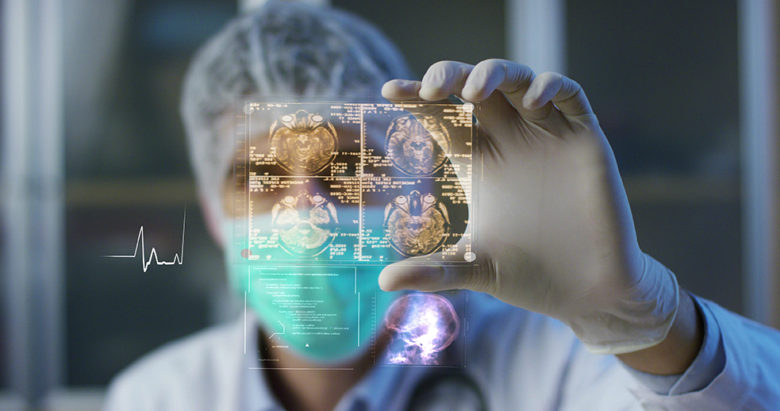
In the hospital of the near future, technology plays a key part in streamlining and enhancing the patient’s experience and delivering high quality care: from wireless physiological monitors to virtual reality entertainment to patients’ health information at their fingertips.
Robots roam the hospital—delivering medication, transporting patients and cleaning. Artificial intelligence (AI), predictive analytics and natural language processing automatically transcribe symptoms and diagnose ailments with a high degree of accuracy, while machine learning algorithms constantly improve the system’s ability to detect and treat medical conditions. Human healthcare providers have been all but eliminated from the equation. It’s the perfect healthcare system – or is it?”
“Medicine is both an art and a science. In order to best serve patients, technology needs to support care providers in doing the things that machines cannot do.”
Depending on who you talk to, this is either a futuristic dream or a technological nightmare. While it is true that our healthcare system could benefit greatly from many of the technologies mentioned above, there is one key element missing: the art of human compassion and caring that is necessary for a truly patient-centric approach to healthcare. Medicine is both an art and a science. In order to best serve patients, technology needs to support care providers in doing the things that machines cannot do. The art of medicine is not just about finding a diagnosis or treating an ailment based on a universally prescribed regimen; it extends into the social realm where human touch, advocacy and empathy are arguably equally important. Medicine is not a one-size-fits-all solution. Cultural norms, family dynamics, genetics, belief systems, and previous experiences all play an important role in patient decision-making. The way in which a provider navigates through these aspects of care greatly influences patients’ autonomy and quality of life. As yet, there is no way to duplicate the complexity of these influences in a machine. There is no such thing as digital compassion.
This isn’t to say that AI doesn’t have tremendous potential to radically transform healthcare for the better. There is no doubt that more accurate diagnoses, fewer medical errors, streamlined documentation, and more nuanced interpretation of large data sets could benefit patients, providers and society as a whole. But maintaining human connection and empathy in a high-tech healthcare system requires careful consideration of how AI and other technologies are implemented – and how they may impact the patient-provider relationship.
Here are several ways AI can support a patient-centered care environment, today and in the future.
Clinical Decision Support
A key way AI can enhance a patient-centered environment is through supporting clinicians rather than replacing them. A great example of this is in providing clinical decision support, highlighting areas of interest or suggesting potential diagnoses or treatment options based on a data set far larger than any human could grasp. While machines are adept at processing large amounts of data, there are many factors that humans are able to account for that machines simply can’t comprehend; on the other hand, humans are barely able to process even a fraction of the data machines can – making a combination of human and machine intelligence the most accurate diagnostic approach. Working together, humans and machines can provide faster and more accurate treatment of conditions to not only address medical issues before they become serious, but also to optimize patients’ health and wellbeing.

Personalized Care
Personalized medicine has been a buzzword since the human genome was first sequenced in 2002 but, unfortunately, reality has not lived up to the hype – yet. Artificial intelligence has the ability to simultaneously analyze far more data points than a human can, and to provide statistical models for potential diagnoses given a particular patient’s unique set of data. There are a number of AI-powered apps on the market which combine AI with medical expertise to interpret a patient’s answers to various questions and respond with a recommended course of action. In some communities where access to high-quality care is limited, this technology is filling the gap and making significant improvements to population health. As an example, Rwanda has a staggering 10,000 residents per doctor, making access to care difficult and expensive; but the introduction of an AI app called Babylon has drastically altered the healthcare landscape. Nearly a third of the population has used the app to access health care advice, dramatically enhancing access to care where providers may not otherwise be available or accessible.
While human involvement in diagnosis and treatment is still critical – all too often AI systems still identify false positives – applications like Babylon can improve the quality of information available to patients, support patient engagement and, ultimately, relieve some of the pressure on overextended healthcare systems around the world.

Patient Data and Privacy
One of the ways AI and machine learning algorithms are trained is to present the system with a large amount of data from which to learn. Unfortunately, this approach is hampered by two challenges particular to healthcare:
- there is a lot of data but most of it is not high quality, and
- most data is not available to researchers because of strict (and necessary) patient privacy regulations.
These limited data sets have a real impact on the effectiveness of AIs: lack of diversity can lead to incorrect assumptions or bias across different populations, a problem that facial recognition and speech recognition algorithms have already struggled with and been publicly criticized for.
University Health Network (UHN) in Toronto has taken a unique approach to solving the patient privacy problem, by creating a patient-controlled system where blockchain is used to control and track who has access to personal health data. The system also allows patients to grant and revoke access to researchers, enhancing transparency and engagement. Other AIs are using natural language processing to read increasingly more complex and messy data sets, improving the quality of data which can then be used to train smarter and more accurate medical AIs.

“Explainable” AI Enhances Trust
Clinicians are trained to analyze data to make connections between different symptoms and draw conclusions about diagnoses and patient health, and may often do so unconsciously. But what happens when an AI simply spits out a percentage of risk? Without context, this information may not be useful to a human doctor interpreting the results, and limits the extent to which the data can be used. This problem has led to the development of a new field of “explainable” AI. These systems not only draw conclusions from diverse sets of data, but can also explain the links between different risk factors and outcomes based on evidence – allowing clinicians better insight into the connections between seemingly unrelated data.
Transparency also builds trust in what may otherwise appear to be a vague and arbitrary output. While trust may seem like a superficial benefit, the transparency and explainability of AIs has real-world impact when it comes to reducing bias and errors in the medical system. From an ethical perspective, it is also important to understand how machines draw their conclusions so that we can ensure they are doing so appropriately.

The Doctor is…Automated?
Automation is a nuanced conversation in any industry, no less so in healthcare where organizations are under increasing pressure to treat aging populations with fewer resources. By now it should be clear that automation can never completely replace humans in providing compassionate care, but that doesn’t mean it has no place in the healthcare industry. Studies have shown that both nurses and doctors spend a significant amount of time on tasks unrelated to patient care, such as documentation, billing, reporting and insurance; not only that, but organizations spend tremendous time and resources ensuring compliance with regulatory and accreditation requirements. In the future, many of these repetitive tasks may be automated, leaving clinicians to focus their attention on what machines can’t do: providing compassionate care to their patients.

Implementing Artificial Intelligence in a Patient-Centric Environment
Today’s AI pales in comparison to what we anticipate it will be capable of in the future – the possibilities are both endless and exciting. We are on the cusp of a radical transformation in healthcare, but it is one that needs to be approached with care and consideration to ensure we don’t end up in a technological dystopia where compassion has been traded for clinical efficiency. There is still a tremendous need for human healthcare professionals to provide care to patients, with or without the assistance of medical AIs; in fact, it is very likely that the rise of AI will make skills like empathy and caring even more valued than they are today.
This vision relies upon bringing together people and technology to create a world where clinicians and patients alike benefit from technologies which augment human cognition, automate non-value-added tasks, and help us better understand ourselves. In the end, perhaps that’s what digital compassion is: allowing technology to support the human connection in a way that blends the art with the science, creating a truly patient-centered care environment.
Author:

Kim Osborne Rodriguez,P.Eng., RCDD
kim.osbornerodriguez@hhangus.com
